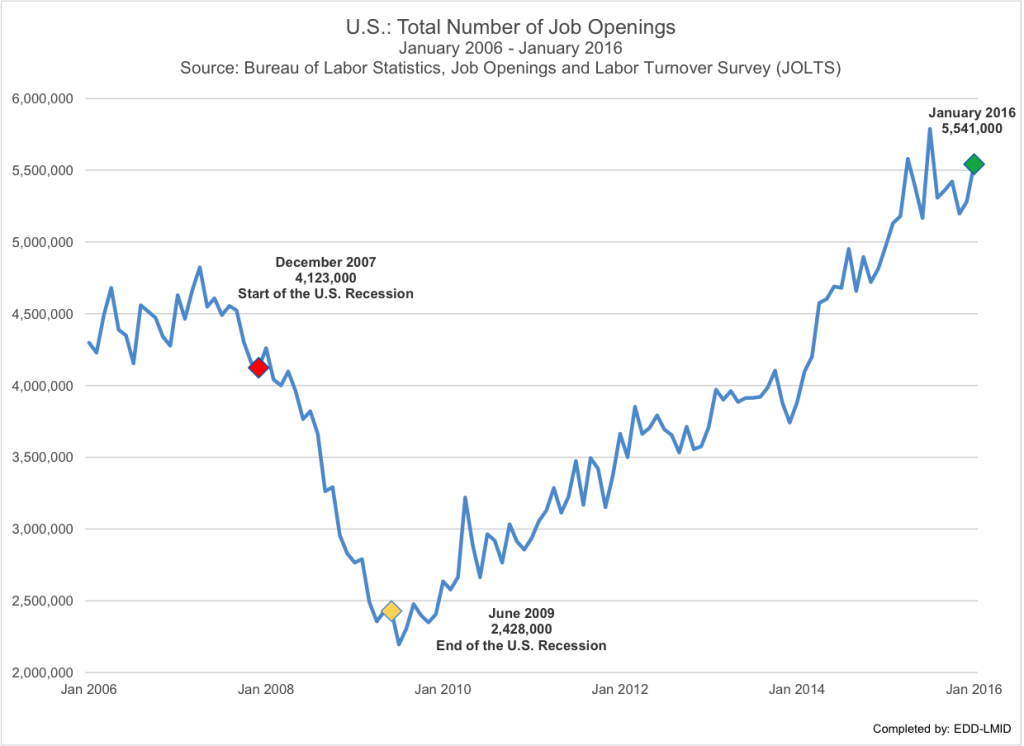 According to the U.S. Bureau of Labor Statistics (BLS), there are more than 600,000 job openings on an average day in California in March 2016. How can this be, with so many Californians having difficulty finding a job.
According to the U.S. Bureau of Labor Statistics (BLS), there are more than 600,000 job openings on an average day in California in March 2016. How can this be, with so many Californians having difficulty finding a job.
Let’s start with the data, and bring in our frequent labor market analyst, Mr. Brandon Hooker of EDD’s Labor Market Information Division (click to enlarge). Mr. Hooker explains that each month BLS surveys employers (private and public) throughout the nation on Hires, Separations and Job Openings. For the Job Openings question, the employer is asked to identify the number of positions for which (i) a specific position exists, (ii) work can start within 30 days, and (iii) the employer is “actively seeking workers”.
The results are shown above. In the most recent survey, January 2016, BLS estimated the number of job openings on the last day of the month (the measurement day for Job Openings) at 5,541,000 nationwide. Neither BLS nor EDD break-down Job Openings to the state level. However, in January 2016, California had 11.4% of the nation’s payroll jobs. Mr. Hooker notes that there is no reason to think that California’s share of the Job Openings differs significantly from its share of payroll jobs. For California, the Job Openings estimate would be 631,674 for the last day of January 2016.
I mention the Job Openings number from time to time in talks and discussions with California workforce professionals and near always get the same response: How can this possibly be, when many of our job seekers are having difficulty securing employment?
Here are three dynamics I see with job seekers today. The result: job search for Californians is far more difficult than it would seem with the number of job openings.
- Even with so many job openings, for most individual openings the competition is intense: For nearly all jobs today, employers are receiving tens if not hundreds of applicants. The ease by which applications can be submitted online is one reason for this. Another reason is that persons employed in jobs, full-time and part-time are often seeking other (better) jobs. Workers are in constant motion around the job world in California. Just as the BLS measures Job Openings; it also measures Hires and Separations. Roughly each month in California there are over 500,000 instances of Separations (voluntary and involuntary) in California and roughly an equal number of Hires. So job seekers are competing not only among unemployed Californians, but also among workers who are employed.
- A significant portion of the listed job openings are not real jobs: Anyone who has utilized the job boards knows that a significant percentage of listings are phony. Many of the jobs on job boards are commission jobs, with no guaranteed pay. Others have candidates already identified, and are posted only to meet legal requirements.
- As the laws and regulations governing hiring have increased in the past decade, employers have become more hesitant about making a “wrong” hiring decision: As government rules governing employment have increased, employers in California have responded in part by turning to independent contractors, project-based employees, and part-time workers. They also have responded by increasing scrutiny in hiring, and a drawing out of the hiring process.
The Great Recession heighted the hesitancy in hiring by highlighting the uncertainties of the economy (and pain of layoffs), for a new generation of employers. The severity of the Great Recession and job loss was on a level far beyond the previous recessions in the early 1990s and early 2000s in California. California employers saw (felt) first hand that contrary to claims by business commentators, the business cycle and its economic downturns were not a thing of the past.
Ever since I began in the California job world in 1979—during good economic times as well as bad—it has been challenging for many job seekers to find employment. It continues to be true today, despite the large number of listed Job Openings.

